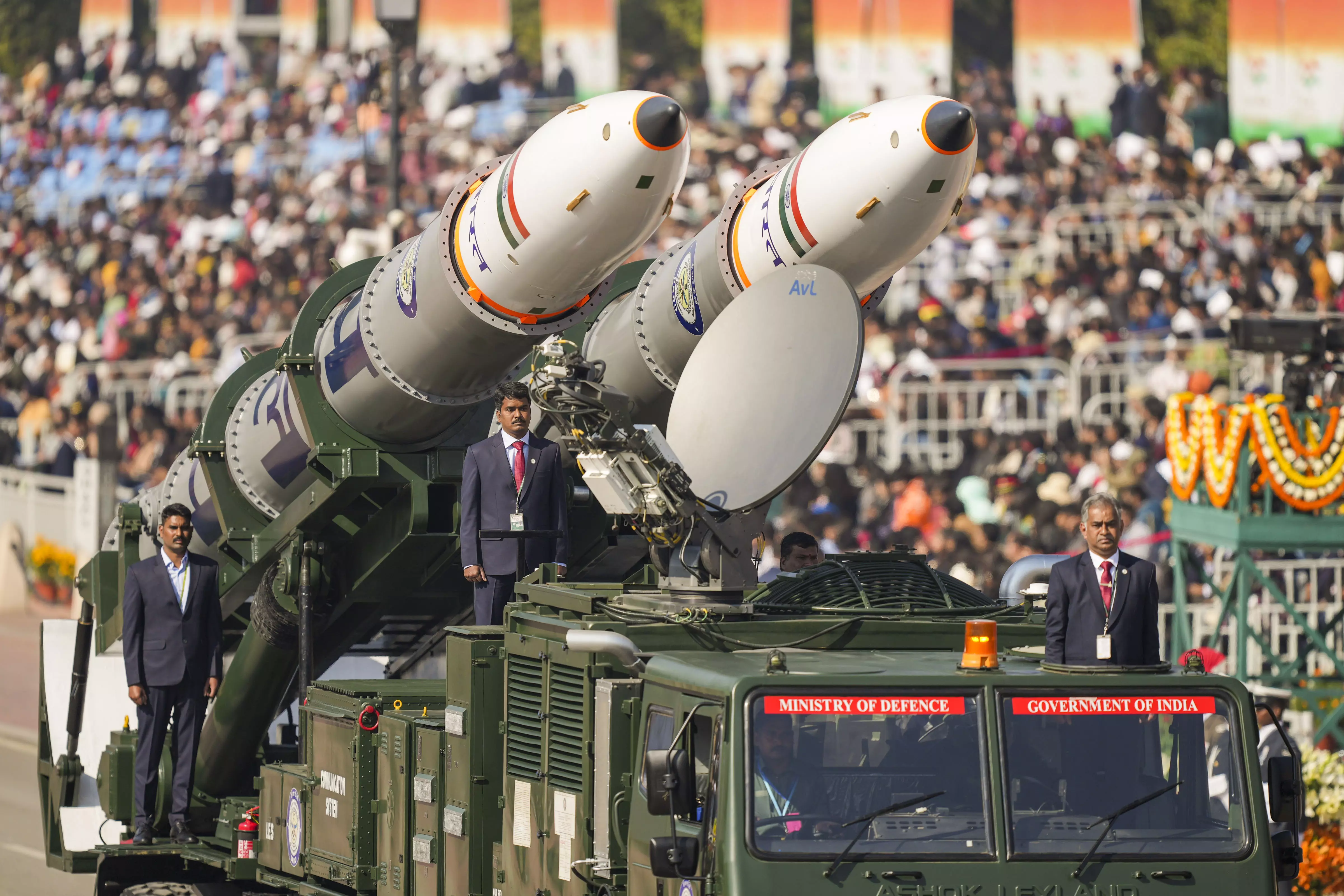R-Day: Missiles, Indigenous Weapons, Military Might Displayed at Parade

�New Delhi:�On the historic occasion of the 75th anniversary of the Republic, India on Sunday celebrated with the customary spectacular parade that showcased a grand display of its military might, elite marching contingents, missiles and various indigenous weapons systems, with Indonesian President Prabowo Subianto gracing the occasion as the chief guest.
For the first time, indigenously-developed short-range tactical missile Pralay, developed by DRDO, capable of carrying a nuclear warhead, was also showcased at the parade. Pralay is a short-range surface-to-surface missile with a payload capacity of 500-1,000 kg and a range of 150 to 500 km.
The parade also displayed a satellite-based surveillance system, medium-power radar Arudhra, advanced lightweight torpedo, electronic warfare system “Dharashakti”, laser-based directed energy weapon, very-short-range air defence and unmanned aerial system.
The parade began with President Droupadi Murmu taking the salute shortly after she and Mr Subianto, flanked by the President’s Bodyguards, arrived in a traditional buggy at the majestic Kartavya Path. Ahead of the parade, President Murmu unfurled the national flag and Prime Minister Narendra Modi paid tribute at the National War Memorial.
Extending greetings, Mr Modi wrote on X: “Happy Republic Day. Today, we celebrate 75 glorious years of being a Republic. We bow to all the great women and men who made our Constitution and ensured that our journey is rooted in democracy, dignity and unity. May this occasion strengthen our efforts towards preserving the ideals of our Constitution and working towards a stronger and prosperous India.”
Since being elected Prime Minister for the first time in 2014, Mr Modi has consistently used his Republic Day and Independence Day appearances as a canvas to celebrate India’s textile diversity and regional craftsmanship. He again transformed the national ceremonial occasion into a stunning visual narrative of the country’s rich cultural heritage with his attire. This time, he wore a red and yellow bandhej “safa” (turban), its vibrant hues complemented by its long, elegantly draping tail. The outfit was anchored by a crisp white kurta-pyjama, with a clean, classic foundation. Completing the look was a brown bandhgala jacket with a tailored silhouette and a vibrant pocket square that added a touch of lively contrast.
The parade saw the presence of village sarpanches, disaster relief workers, Asha workers and Paralympic athletes among the 10,000 special guests. The invitation was sent to the special guests from diverse fields in line with the government’s objective to increase “Jan Bhagidari” in events of national importance. These included people who made the best use of government schemes.
The 76th Republic Day parade saw more than 18 marching contingents, 31 tableaux, and more than 5,000 folk and tribal artists performing 45 dance forms from different parts of the country. The cultural performers covered the entire Kartavya Path -- for the first time -- to ensure that all guests get the same viewing experience. The 11-minute performance titled “Jayati Jaya Mama? Bharatam” was curated by the Sangeet Natak Akademi.
The parade’s military spectacle began with the 61st Cavalry, raised in 1953, which is the world’s only active horse cavalry regiment. In a rare coincidence, parade commander Lt. Gen. Bhavnish Kumar took part in the parade with his son Lt. Ahan Kumar, who led the contingent of the iconic 61st Cavalry. It was followed by nine mechanised columns and nine marching contingents.
The T-90 Bhishma tank, the NAG missile systems, the BrahMos supersonic cruise missile, the Pinaka multi-launcher rocket system, the Agnibaan multi-barrel rocket launcher, the Akash weapon system, the integrated battlefield surveillance system and all-terrain vehicle (Chetak) were among the key displays by the mechanised columns.
Light specialist vehicle Bajrang, vehicle-mounted infantry mortar system Airawat, quick reaction force vehicles Nandighosh and Tripurantak and the short-span bridging system were also on display.
In a first, a tri-services tableau, depicting the broader spirit of “jointness” among the armed forces, rolled down the centrepiece boulevard of the national capital. It displayed a battlefield scenario, demonstrating a synchronised operation in land, water and air with the indigenous Arjun battle tank, Tejas fighter aircraft and advanced light helicopter. The theme of the tri-services tableau was “Shashakt aur Surakshit Bharat” (strong and secure India).
Showcasing India’s cultural diversity, tableaux from 16 states, Union territories and Central government departments took part in the parade. The theme of Andhra Pradesh’s tableau was “Etikoppaka Bommalu”, featuring eco-friendly wooden toys. While Uttar Pradesh displayed its Maha Kumbh tableau, West Bengal showcased its “Lakshmir Bhandar” and “Lok Prasar Prakalpa” tableau, highlighting the state government’s welfare schemes.
Clad in an iconic red sari, the embodiment of the Indian woman stood tall on the tableau by the ministry of women and child development at the parade. In “shakti swaroop”, as the ministry termed the installation, the depiction featured five pairs of hands -- each brandishing one tool that depicted the various roles women play in day-to-day lives.
A daring group of soldiers performed breathtaking stunts on motorcycles, leaving viewers in awe, as part of the celebrations. Known as the “Daredevils”, the motorcycle rider display team of the Army’s Corps of Signals showcased their exceptional skills, indomitable courage and teamwork and attempted to set two world records in the process.
For the first time, a marching and band contingent from Indonesia participated in the parade, further highlighting the close ties between the two nations. On the domestic front, the parade also included a 148-member all-women contingent from the CRPF and marching units from the Assam Rifles, the BSF’s camel contingent and the National Cadet Corps.
